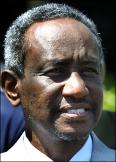Peace accord predicted as Sudan foes meet
 NAIROBI, Dec 7 (AFP) — Sudan’s vice president and the leader of the country’s main rebel group resumed face-to-face talks in Kenya amid predictions they will clinch an end to two decades of war before the end of the month.
NAIROBI, Dec 7 (AFP) — Sudan’s vice president and the leader of the country’s main rebel group resumed face-to-face talks in Kenya amid predictions they will clinch an end to two decades of war before the end of the month.
Journalists were excluded from the meeting between Osman Ali Taha and Sudan People’s Liberation Movement/Army (SPLM/A) leader John Garang, being held in a hotel near the town of Naivasha.
With several key agreements already behind them, the two leaders are now set to try to iron out their differences on three issues: power-sharing, wealth distribution — notably of the country’s lucrative onstream oil reserves — and the status of three disputed areas not officially considered part of the south.
“Everybody is optimistic that an agreement could be reached in this session, but other implementation details will be worked out later,” an official of the international mediating body, the Inter-Governmental Authority on Development, told AFP by phone.
In Cairo on Saturday, Sudanese Foreign Minister Mustafa Ismail told reporters a deal would be signed “at the end of the current year”.
Taha and Garang committed themselves to this deadline when United States Secretary of State Colin Powell met them both in Naivasha in October.
Sudan’s civil war flared up again in 1983 — after the collapse of a 1972 peace accord — when rebels in the south, where most people observe traditional religions or Christianity, rose up to end their domination by successive Islamic Khartoum governments.
The conflict, in which oil reserves have played an increasingly significant role over recent years, has killed at least 1.5 million people and displaced more than four million.
Preliminary discussions by delegates in Naivasha produced “substantial progress, notably on… power sharing,” according to one source there.
Previous rounds, also in Kenya, have yielded success. Last year the foes agreed that, after six years of self-rule from the day a final accord is reached, the south will hold a referendum on whether to join the north — and under what arrangement — or secede.
In September, Garang and Taha clinched a deal on transitional security arrangements.
Some aspects of these arrangements — which concern the deployment of both sides’ forces during the interim period — have yet to be ironed out.
In the disputed Nuba Mountains region for example, where the population has been bombed, raped and starved over the years, the SPLA will seek guarantees of a balanced presence of forces.
Hopes for peace were also fuelled on Friday, when SPLM/A leaders made a historic visit to Khartoum that prompted a triumphant welcome from thousands of supporters.
The head of the delegation, Bagan Amum, described the trip as a “goodwill visit” to show the people of Sudan “it was time to end a chapter of fighting and open a new chapter of peace”.
Beshir told national television: “All indications are that the war in southern Sudan… is reaching its end and only the finishing touches need to be put on a final peace agreement.”
On Thursday, Taha signed a deal with Mohammed Osman Mirghani, the leader of the National Democratic Alliance, a coalition of opposition forces, including the SPLA.
But even if Taha and Garang sign a comprehensive accord this year, real peace will depend on a separate deal being reached with another rebel group, the Sudan Liberation Movement, in the western Dafur regions, where fighting has raged since February despite a ceasefire being signed in September.
